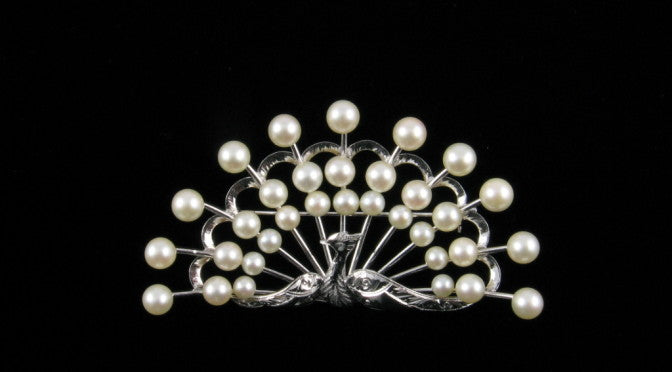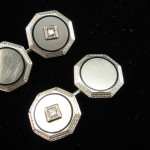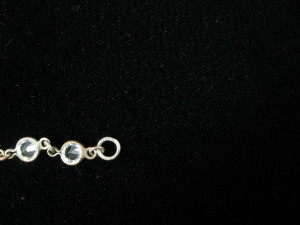Dating jewelry is done through multiple methods: looking at design and stylistic clues; at construction techniques; at hallmarks; at materials used; and at patent numbers. However there are certain discoveries, inventions, and historic events that are milestones in jewelry history and knowing a few of them can help narrow down the date of a lot of pieces and eliminate some faulty attributions. I’ve arranged these chronologically and included items of interest to collectors of both fine and costume jewelry.
Georgian Jewelry:
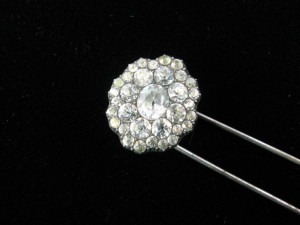 Front of Georgian Hair Ornament with Stones Set in Silver
Front of Georgian Hair Ornament with Stones Set in Silver
1767: James Cox developed a method of backing silver with a thin sheet of gold in 1767. This is significant in dating jewelry since it means gold-backed silver is post-1767, and not from the earliest decades of the Georgian era. However, the absence of gold backing does not mean that a piece is pre-1767.
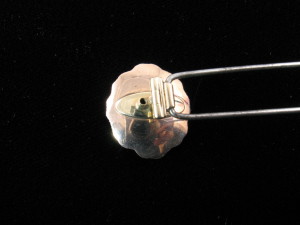 Gold Back of Georgian Hair Ornament (hair pin is later addition)
Gold Back of Georgian Hair Ornament (hair pin is later addition)
1777: Manufacturing technique of die stamping started to be used in jewelry manufacturing in 1777. This means that not all Georgian jewelry was completely handmade.
Victorian/Early 20th Century:
1854: The British began to allow production of jewelry using 9 carat, 12 carat, and 15 carat gold in 1854. Prior to this date British gold jewelry was supposed to be 18 carat gold. Therefore, if jewelry is marked 9, 12, or 15 carat it is post-1854. However the alloys used in earlier jewelry were sometimes inconsistent and may test as lower than 18 carat so the presence of lower-grade gold doesn’t automatically date a piece as post-1854.
(Another interesting fact: in Britain gold is spelled “carat” with a “c”; in the United States “karat” is spelled with a “k”. In the absence of other indicators this can help you determine country of origin.)
1870: The word “Sterling” started to be stamped on US jewelry. Prior to 1870 coin silver (900 silver) was the US standard.
1895: the oxyacetylene torch was invented in 1895, which enabled jewelers to melt and cast platinum and fuse it to itself. Prior to this invention, small amounts of platinum occasionally appeared in jewelry, but there was no torch hot enough to commercially produce platinum jewelry. This, combined with the discovery of diamonds in South Africa, led to the dominance of “white” jewelry at the end of the 19th century and the first decades of the twentieth century. And platinum’s strength allowed for the delicate pierced work characteristic of Edwardian jewelry.
1902: The Vernuil flame-fusion process of creating synthetic sapphires and rubies was invented. While some other methods of producing synthetic gemstones had previously been invented, this was the first commercially successful and economical method of producing synthetic stones. Synthetic rubies started to appear commercially in 1905 and synthetic sapphires in 1911.
1915: The alloy for white gold was patented in the US in 1915, a couple of years earlier in Germany. In addition, platinum was deemed a “strategic metal” in WWI, so its use in jewelry severely limited, and white gold used as a substitute. Therefore if a piece of jewelry is made using white gold it is post-1914, when WWI began.
1916: Spherical cultured pearls began to be commercially produced by Mikimoto in 1916 (he had previously patented a method of producing mabe – aka blister – pearls in 1896). After this date, unless you have a gemological report confirming that the pearls are natural, it should be assumed that they are cultured. If a piece of pearl jewelry is clearly pre-1916, there is a good chance that the pearls are natural (although larger, valuable, natural pearls were sometimes sold and replaced with cultured pearls).
1918: The country known as Czechoslovakia was formed following WWI. Therefore, if a piece of jewelry is marked “Czech” or “Czechoslovakia” it is post-1918.
Late 20th Century:
1955: the technology for creating the iridescent rhinestones known as “aurora borealis” was developed in 1955. Therefore when dating costume jewelry, pieces containing aurora borealis stones are post-1955.
1967: Discovery of tanzanite and tsavorite garnets in Tanzania.
1976: Commercial production of cubic zirconia (CZ) began in 1976. Therefore jewelry with CZ stones is post-1976.
1980: The style of hallmarking Mexican jewelry changed around 1979-80. From 1948 until that time Mexican jewelry was hallmarked with an eagle assay mark. After 1980 Mexican jewelry was hallmarked with a string of letters and numbers: a pair of letters followed by a hyphen, followed by two or three numbers. Therefore Mexican jewelry with an eagle assay mark will date from 1948-1980; Mexican jewelry with a string of letters and numbers will be post-1980. Sometimes maker’s marks and other indicators can help in dating a piece to a narrower window.
If there is no eagle assay mark and no string of letters and numbers this MAY mean that a piece is earlier than 1948, however, it also may mean that they piece was not sent to an assay office for hallmarking.


